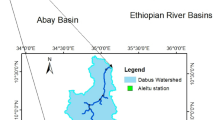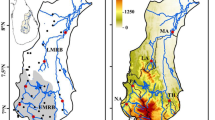Abstract
The main aim of this study was to setup and evaluate the applicability of physically based soil and water assessment tool (SWAT) model with ArcGIS version 9.3 in assessing the runoff and sediment load from Mojo watershed having a total area of 2017.21 km2 situated in central Oromia Regional state, Ethiopia. In this study for stream flow simulation parameters involving surface runoff (CN2.mgt) and ground water (ALPHA_BNK.rte) are found the most sensitive parameter and the parameters representing channel process (SPCON.bsn, SPEXP.bsn &ADJ_PKP.bsn), geomorphology (SLSUBBSN.hru) and surface runoff (CN2.mgt, & HRU_SLP.hru), were found more sensitive for sediment load simulation. There are a good agreement between the observed and simulated discharge, which was verified using both graphical technique and quantitative statistics. The value of R 2 = 0.75, NSE = 0.76, RSR = 0.49 and PBIAS = 10.9 obtained during calibration and R 2 value 0.71, NSE value 0.70, RSR value 0.59 and PBIAS 9.5 obtained during validation as well as the uniformly scatter points along the 1:1 line during calibration and validation justify that the model is good in simulating runoff from Mojo watershed. For sediment load the computed statistical indicators R 2 = 0.77, NSE = 0.76, RSR = 0.49 and PBIAS = 48.70 were obtained during calibration and during validation the computed statistical indicators were found 0.67 for R 2, 0.65 for NSE, 0.59 for RSR and 50.5 for PBIAS. From the calibration and validation result, it can be concluded that the calibrated parameter values of SWAT model can be used for hydrologic simulation of the un-gauged watershed that is having the similar agro-climatic condition.








Similar content being viewed by others
References
Abbaspour KC (2012) SWAT-calibration and uncertainty programs. http://swat.tamu.edu/software/swat-cup/. Accessed 18 June 2015
Arnold JG, Fohrer N (2005) SWAT2000 current capabilities and research opportunities in applied watershed modeling. Hydrol Process 19:563–572
Arnold JG, Srinivasan R, Muttiah RS, Williams JR (1998) Large area hydrologic modeling and assessment. J Am Water Resour Assoc 34(1):73–89
Arnold JG, Moriasi DN, Gassman PW, Abbaspour KC, White MJ, Srinivasan R, Santhi C, Harmel RD, van Griensven A, Van Liew MW, Kannan N, Jha MK (2012) SWAT model use, calibration, and validation. Trans ASABE 55(4):1491–1508
Coffey AE, Workman SR, Taraba JL, Fogle AW (2004) Statistical procedures for evaluating daily and monthly hydrologic model predictions. Trans ASAE 47(1):59–68
FAO (1998) World reference base for soil resources, world soils report no. 84, Rome
Fontaine TA, Cruickshank TS, Arnold JG, Hotchkiss RH (2002) Development of a snowfall–snowmelt routine for mountainous terrain for the soil and water assessment tool. J Hydrol 262(1–4):209–223
Griensven A, Meixner T, Grunwald S, Bishop T, Diluzio M, Srinivasan R (2006) A global sensitivity analysis tool for the parameters of multi-variable catchment models. J Hydrol 324:10–23
Gupta HV, Sorooshian S, Yapo PO (1999) Status of automatic calibration for hydrologic models: comparison with multilevel expert calibration. J Hydrol Eng 4(2):135–143
Jajarmizadeh M, Harun S, Abdullah R, Salarpour M (2012) Using soil and water assessment tool for flow simulation and assessment of sensitive parameters applying SUFI-2 algorithm. Casp J Appl Sci Res 2(1):37–44. http://www.cjasr.com. Accessed 20 June 2015 (ISSN: 2251-9114)
Knisel WG (1980) CREAMS, a field scale model for chemicals, runoff and erosion from agricultural management systems. USDA Conservation Research Rept. No. 26, Washington DC
Krause P, Boyle DP, Base F (2005) Comparison of different efficiency criteria for hydrological model assessment. Adv Geosci 5:89–97
Leonard RA, Knisel WG, Still DA (1987) GLEAMS: groundwater loading effects of agricultural management systems. Trans ASAE 30:1403–1418
Margaret WG, Chaubey I (2010) Regionalization of SWAT model parameters for use in ungauged watersheds. www.mdpi.com/journal/water. Accessed 15 June 2015
Matamoros D, Guzman E, Bonini J, Vanrolleghem PA (2005) AGNPS and SWAT model calibration for hydrologic modeling of an Ecuadorian river basin under data scarcity. IWA Publishing, London
Mengistu D, Sorteberg A (2012) Sensitivity of SWAT simulated stream flow to climatic changes within the Eastern Nile River basin. Hydrol Earth Syst Sci 16:391–407
Merritt WS, Letcher RA, Jakeman AJ (2003) A review of erosion and sediment transport models. Environ Model Softw 18:761–799
Migliaccio KW, Srivastava P (2007) Hydrologic components of watershed-scale models. Trans ASABE 50(5):1695–1703
Mishra A, Kar S, Pandey AC (2008) Comparison of SWAT with HSPF model in predicting hydrologic processes of a small multi-vegetated watershed. J Agric Eng 45(4):29–35
Morgan RPC (1995) Soil erosion and conservation, 2nd edn. Longman Group Unlimited, London, p 198
Moriasi DN, Arnold JG, Van Liew MW, Bingner RL, Harmel RD, Veith TL (2007) Model evaluation guidelines for systematic quantification of accuracy in watershed simulations. Trans ASABE 50(3):885–900
Neitsch SL, Arnold JG, Kiniry JR, Williams JR, King KW (2002) Soil and water assessment tool, theoretical documentation, Black land research center, grassland, soil and water research laboratory, agricultural research service, Temple, TX
Neitsch SL, Arnold JG, Kiniry JR, Williams JR, King KW (2011) Soil and water assessment tool. Theoretical documentation: version 2009. TWRI TR-406. Texas Water Resources Institute, College Station, TX, pp 647
Ogwo V, Ogbu KN, Okoye CJ, Okechukwu ME, Mbajiorgu CC (2012) Comparison of soil erosion models for application in the humid tropics. Spec Publ Niger Assoc Hydrol Sci 266–278
Parajuli PB, Ouyang Y (2013) Watershed-scale hydrological modeling methods and applications. http://creativecommons.org/licenses/by/3.0. Accessed 21 May 2015
Reungsang P, Kanwar RS, Jha M, Gassman PW, Ahmad K, Saleh A (2005) Calibration and validation of SWAT for the Upper Maquoketa River watershed. Center for Agricultural and Rural Development, Iowa State University. www.card.iastate.edu. Accessed 5 July 2015
Santhi C, Arnold JG, Williams JR, Dugas WA, Srinivasan R, Hauck LM (2001) Validation of the SWAT model on a large river basin with point and nonpoint sources. J Am Water Resour Assoc 37(5):1169–1188
Stefan L (2003) The PCPSTAT program user’s manual. http://swat.tamu.edu/media/83150/manual-PCPSTAT. Accessed 5 Apr 2015
Williams JR (1975) Sediment routing for agricultural watersheds. Water Resour Bull 11(5):965–974
Williams JR, Jones CA, Dyke PT (1984) A modeling approach to determining the relationship between erosion and productivity. Trans Am Soc Agric Eng 27(1):129–144
Wischmeier WH, Smith DD (1978) Predicting rainfall erosion losses: a guide to conservation planning. Agricultural Handbook No. 537 (USDA), Washington, DC
Xie H, Longuevergne L, Ringler C, Scanlon BR (2012) Calibration and evaluation of a semi-distributed watershed model of Sub-Saharan Africa using GRACE data. Hydrol Earth Syst Sci 16:3083–3099
Yongwei G, Zhenyao S, Ruimin L, Xiujuan W, Chen T (2010) Effect of watershed subdivision on SWAT modeling with consideration of parameter uncertainty. J Hydrol Eng 2010(15):1070–1074
Zhang X, Srinivasan R, Zhao K, Van Liew M (2008) Evaluation of global optimization algorithms for parameter calibration of a computationally intensive hydrologic model. Wiley Inter Science. http://www.interscience.wiley.com. doi:10.1002/hyp.7152
Zhang X, Srinivasan R, Boschc D (2009) Calibration and uncertainty analysis of the SWAT model using genetic algorithms and Bayesian model averaging. J Hydrol 374:307–317
Acknowledgements
The authors wish to thank the staff member of Ethiopian National Metrology Service Agency and Ethiopian Federal Ministry of Water Resources for their kind cooperation and support in providing the necessary data for this study. The authors also would like to acknowledge the cooperation of Mr. Dawit Endale in providing soil and land use data.
Author information
Authors and Affiliations
Corresponding author
Rights and permissions
About this article
Cite this article
Biru, Z., Kumar, D. Calibration and validation of SWAT model using stream flow and sediment load for Mojo watershed, Ethiopia. Sustain. Water Resour. Manag. 4, 937–949 (2018). https://doi.org/10.1007/s40899-017-0189-1
Received:
Accepted:
Published:
Issue Date:
DOI: https://doi.org/10.1007/s40899-017-0189-1




